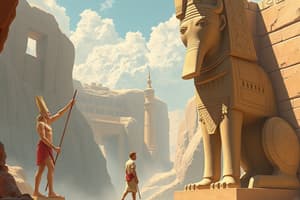Podcast
Questions and Answers
What was the focus of 18th century Romanticism?
What was the focus of 18th century Romanticism?
- Achieving perfect likeness
- Imitation of Classical antiquity
- Originality (correct)
- Revolution in the visual arts
What did Plato advise in The Republic regarding art and artists?
What did Plato advise in The Republic regarding art and artists?
- Encouragement of art as imitation and inclusion of artists
- Banning of both art and artists
- Inclusion of art in the curriculum and banning of artists (correct)
- Exclusion of art from the curriculum and encouragement of artists
Inward imitation, as described in the text, refers to the imitation of:
Inward imitation, as described in the text, refers to the imitation of:
- Physical objects
- Hair styles and color
- Culture-based behavior (correct)
- Dressing codes
Which type of art is described as depicting something easily recognized by most people without doubt?
Which type of art is described as depicting something easily recognized by most people without doubt?
What characterized 20th-century perception of 'art as imitation', according to the text?
What characterized 20th-century perception of 'art as imitation', according to the text?
According to Aristotle, how did he view representational art?
According to Aristotle, how did he view representational art?
In Immanuel Kant's 'Critique of Judgment', how did he describe the judgment of beauty?
In Immanuel Kant's 'Critique of Judgment', how did he describe the judgment of beauty?
According to Leo Tolstoy, what role does art play in communicating emotions to its audience?
According to Leo Tolstoy, what role does art play in communicating emotions to its audience?
What is the difference between aesthetic judgment and judgment of taste, according to Immanuel Kant?
What is the difference between aesthetic judgment and judgment of taste, according to Immanuel Kant?
How did Aristotle differ from Plato in their views on art?
How did Aristotle differ from Plato in their views on art?
Flashcards are hidden until you start studying




